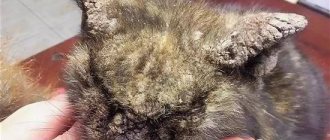Cats are very active and mobile, especially those that have access to the street and walk there for a long time on their own. Due to high activity, the cat can get wounded or injured.
Owners often encounter such situations and sometimes the wound is confused with a serious illness. For example, a fistula formed in a cat can resemble a wound, and the owners, without paying attention to it, try to cope on their own.
Fistula in a cat is a serious disease that requires immediate treatment. This disease is a hole from an organ to the outside or an internal hole between two organs.
In the photo of a fistula in a cat, you can see that it differs from the wound. And we’ll talk about what it is, what the symptoms may be and how fistula in a cat is treated in this article.
Congenital and acquired fistulas
In order to understand how to treat fistulas in a cat, you need to be able to recognize them. The congenital type of the disease is the presence of a channel from the body cavities to the outside. Most often in kittens, such a canal comes from the abdominal cavity.
Of course, the congenital defect itself does not pose any harm to health, but due to the fact that it opens access to internal cavities, a virus can get there.
This deviation occurs if the mother cat was sick while carrying kittens and her immune system was weakened.
Acquired fistulas are a serious pathology that can lead to the death of a pet. They have a slightly different structure from the congenital ones.
If the canal of a congenital fistula consists of healthy tissue, then the tissue here is hyperemic, that is, painful.
Such fistulas can occur as a result of penetrating wounds with infection of surrounding tissues. Another reason is injury from bone fragments during fractures. The second option heals on its own and does not require any intervention.
Fistulas can also occur after operations. Such varieties indicate an incorrect operation process and a violation of the aseptic regime.
A fistula in a cat under the tail can appear due to improper castration. Pus accumulates and seeks a way out, creating ducts on its own in the form of fistulas.
Another option for the occurrence of a pathological fistula is home treatment for dangerous inflammatory processes.What can a pet owner do?
Inflammation of the paraanal glands in a cat is always easier to prevent than to cure. Therefore, experts recommend that animal owners carry out preventive anal cleanings every 4-6 months. The procedure should be carried out with gloves.
Method of paraanal cleaning:
- Lubricate your index finger with Vaseline and insert it into the cat’s rectum;
- use your thumb and index finger to palpate the paraanal gland, which is shaped like an oval formation;
- squeeze out the secretion of the gland using massage movements;
- Wipe off any excess liquid with a tissue.
The procedure for cleaning the anal sacs can hardly be called pleasant, so in some cases, pet owners entrust it to a specialist.
Symptoms and diagnosis of the disease
The external fistula looks like a funnel from the internal cavity. Depending on where the fistula is located on the internal organ, different contents are released from it.
This hole does not close on its own. Liquid constantly leaks out of it and the fur around the area becomes crusty and sticks together.
Another noticeable symptom of a fistula in a cat is an unpleasant odor that comes from the site of the injury. If you have these symptoms, you should immediately contact a specialist. The most difficult type of fistula in a cat is paraanal.
Seizures in cats - main causes, symptoms, first aid, treatment and choice of drugs (110 photos)Polycystic kidney disease in cats - causes, diagnosis and symptoms of the disease. Treatment options and prevention of kidney disease (95 photos)
Tartar in cats - signs of the disease and methods of fully treating tartar (125 photos + video)
A doctor can easily diagnose a cat's fistula in the abdomen and other areas with the help of additional tests. This will most likely include an external examination, collection of tests, and ultrasound.
If a fistula is found on the cat's back, then this is most likely an indicator of a tumor and a biopsy is necessary.
An internal fistula cannot be recognized by external symptoms, since they appear only in severe stages. In this case, treatment may not have any effect.Treatment methods for paraproctitis
Complete cure is only possible through surgery. Physical therapy, antibiotics, and ointments are used in preparation for or after surgery. Drug therapy can also relieve symptoms and speed recovery. Main recommended pharmacological groups:
- painkillers;
- systemic antibiotics;
- healing ointments.
A course of physiotherapy may include ultraviolet irradiation and electrophoresis.
SM-Clinic specialists diagnose and treat complex pathologies. To make a diagnosis, the doctor collects the patient’s complaints, medical history and objective examination. To clarify the diagnosis and carry out differential diagnosis, additional instrumental studies are performed, such as anoscopy and sigmoidoscopy. These studies are carried out after cleansing the intestines by performing cleansing enemas and taking laxatives.
Photo of a fistula in a cat
Ringworm in cats - main signs, symptoms, prevention and treatment of ringworm in cats (105 photos)Pancreatitis in cats: first symptoms, nutritional nuances and treatment options (125 photos and videos)
- Subcutaneous mites in cats - first symptoms, treatment options and real photos of examples of parasite damage (110 photos + video)
https://www.youtube.com/watch?v=I0vJiLXL3b
Read here Worms in cats - main symptoms, treatment methods and the best drugs of 2022 (135 photos + video)
Help the site, share with friends 











